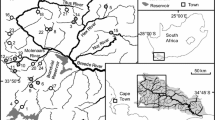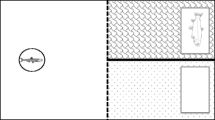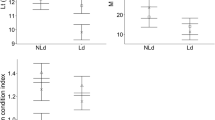Abstract
Replacement of a native species by a nonnative can have strong effects on ecosystem function, such as altering nutrient cycling or disturbance frequency. Replacements may cause shifts in ecosystem function because nonnatives establish at different biomass, or because they differ from native species in traits like foraging behavior. However, no studies have compared effects of wholesale replacement of a native by a nonnative species on subsidies that support consumers in adjacent habitats, nor quantified the magnitude of these effects. We examined whether streams invaded by nonnative brook trout (Salvelinus fontinalis) in two regions of the Rocky Mountains, USA, produced fewer emerging adult aquatic insects compared to paired streams with native cutthroat trout (Oncorhynchus clarkii), and whether riparian spiders that depend on these prey were less abundant along streams with lower total insect emergence. As predicted, emergence density was 36% lower from streams with the nonnative fish. Biomass of brook trout was higher than the cutthroat trout they replaced, but even after accounting for this difference, emergence was 24% lower from brook trout streams. More riparian spiders were counted along streams with greater total emergence across the water surface. Based on these results, we predicted that brook trout replacement would result in 6–20% fewer spiders in the two regions. When brook trout replace cutthroat trout, they reduce cross-habitat resource subsidies and alter ecosystem function in stream-riparian food webs, not only owing to increased biomass but also because traits apparently differ from native cutthroat trout.

Similar content being viewed by others
References
Adams SB, Frissell CA, Rieman BE (2002) Changes in distribution of nonnative brook trout in an Idaho drainage over two decades. Trans Am Fish Soc 131:561–568
Baxter CV, Fausch KD, Murakami M, Chapman PL (2004) Non-native stream fish invasion restructures stream and forest food webs by interrupting reciprocal prey subsidies. Ecology 85:2656–2663
Baxter CV, Fausch KD, Saunders WC (2005) Tangled webs: reciprocal flows of invertebrate prey link streams and riparian zones. Freshw Biol 50:201–220
Behnke RJ (1992) Native trout of western North America. American Fisheries Society, Bethesda
Benjamin JR, Baxter CV (2010) Do nonnative salmonines exhibit greater density and production than the natives they replace? A comparison of nonnative brook trout to native cutthroat trout. Trans Am Fish Soc 139:641–651
Burnham KP, Anderson DR (2002) Model selection and multi-model inference: a practical information-theoretic approach. Springer-, New York
Carlsson NOL, Bronmark C, Hansson L (2004) Invading herbivory: the golden apple snail alters ecosystem functioning in Asian wetlands. Ecology 85:1575–1580
Dahl J (1998) Effects of a benthivorous and a drift-feeding fish on a benthic stream assemblage. Oecologia 116:426–432
Diamond J (1986) Overview: laboratory experiments, field experiments, and natural experiments. In: Diamond J, Case T (eds) Community ecology. Harper and Row, New York, pp 3–22
Doherty PF, White GC, Burnham KP (2011) Comparison of model building strategies when all possible model structures cannot be constructed. J Ornithol (in press, available online)
Dunham JB, Rahn ME, Schroeter RE, Breck SW (2000) Diets of sympatric Lahontan cutthroat trout and nonnative brook trout: implications for species interactions. Western N Am Nat 60:304–310
Epanchin P, Knapp R, Lawler S (2010) Nonnative trout impact an alpine-nesting bird by altering aquatic insect subsidies. Ecology 91:2406–2415
Fausch KD (2008) A paradox of trout invasions in North America. Biol Invasions 10:685–701
Fausch KD, White RJ (1981) Competition between brook trout (Salvelinus fontinalis) and brown trout (Salmo trutta) for positions in a Michigan stream. Can J Fish Aquat Sci 38:1220–1227
Fausch KD, Nakano S, Kitano S (1997) Experimentally induced foraging mode shift by sympatric charrs in a Japanese mountain stream. Behavioral Ecol 8:414–420
Fausch KD, Rieman BE, Dunham JB, Young MK, Peterson DP (2009) The invasion versus isolation dilemma: tradeoffs in managing native salmonids with barriers to upstream movement. Conserv Biol 23:859–870
Finlay JC, Vredenburg VT (2007) Introduced trout sever trophic connections in watersheds: consequences for a declining amphibian. Ecology 88:2187–2198
Forrester GE, Chace JG, McCarthy W (1994) Diel and density-related changes in food consumption and prey selection by brook charr in a New Hampshire stream. Environ Biol Fish 39:301–311
Fukui D, Murakami M, Nakano S, Aoi T (2006) Effect of emergent aquatic insects on bat foraging in a riparian forest. J Anim Ecol 75:1252–1258
Gillespie RG (1987) The mechanism of habitat selection in the long-jawed orb-weaving spider Tetragnatha elongata (Araneae, Araneidae). J Arachnol 15:81–90
Gordon DR (2008) Effects of invasive, non-indigenous plant species on ecosystem processes: lessons from Florida. Ecol Appl 8:975–989
Gratton C, Vander Zanden MJ (2009) Flux of aquatic insect productivity to land: comparison of lentic and lotic ecosystems. Ecology 9:2689–2699
Gresswell RE (ed) (1988) Status and management of interior stocks of cutthroat trout. American Fisheries Society Symposium 4, Bethesda
Griffith JS (1972) Comparative behavior and habitat utilization of brook trout (Salvelinus fontinalis) and cutthroat trout (Salmo clarki) in small streams in northern Idaho. J Fish Res Bd Can 29:265–273
Griffith JS (1974) Utilization of invertebrate drift by brook trout (Salvelinus fontinalis) and cutthroat trout (Salmo clarki) in small streams in Idaho. Trans Am Fish Soc 3:440–447
Hall RO Jr, Dybdahl MF, VanderLoop MC (2006) Extremely high secondary production of introduced snails in rivers. Ecol Appl 16:1121–1131
Holway DA, Lach L, Suarez AV, Tsutsui ND, Case TJ (2002) The causes and consequences of ant invasions. Annu Rev Ecol Syst 33:181–233
Hooper DU, Chapin FS III, Ewel JJ, Hector A, Inchausti P, Lavorel S, Lawton JH, Lodge DM, Loreau M, Naeem S, Schmid B, Setälä H, Symstad J, Vandermeer J, Wardle DA (2005) Effects of biodiversity on ecosystem functioning: a consensus of current knowledge. Ecol Monogr 75:3–35
Iwata T (2006) Linking stream habitats and spider distribution: spatial variations in trophic transfer across a forest-stream boundary. Ecol Res 22:619–628
Kato C, Iwata T, Nakano S, Kishi D (2003) Dynamics of aquatic insect flux affects distribution of riparian web-building spiders. Oikos 103:113–120
Laeser SL, Baxter CV, Fausch KD (2005) Riparian vegetation loss, stream channelization and web-weaving spiders in northern Japan. Ecol Res 20:646–651
Levine JM, Vila M, Antonio CM D, Dukes JS, Grigulis K, Lavorel S (2003) Mechanisms underlying the impacts of exotic plant invasions. Proc R Soc Lond B 270:775–781
Littell RC, Milliken GA, Stroup WW, Wolfinger RD, Schabenberger O (2006) SAS for Mixed Models, 2nd edn. SAS Institute, Cary
Malison RL, Benjamin JR, Baxter CV (2010) Measuring adult insect emergence from streams: the influence of trap placement and a comparison with benthic sampling. J North Am Benthol Soc 29:647–656
Marczak LB, Richardson JS (2007) Spider and subsidies: results from the riparian zone of a coastal temperate rainforest. J Anim Ecol 76:687–694
Marczak LB, Richardson JS (2008) Growth and development rates in a riparian spider are altered by asynchrony between the timing and amount of a resource subsidy. Oecologia 156:249–258
McCune B, Grace JB (2002) Analysis of ecological communities. MJM Software Design, Gleneden Beach
McDowall RM (2006) Crying wolf, crying foul, or crying shame: alien salmonids and a biodiversity crisis in the southern cool-temperate galaxioid fishes? Rev Fish Biol Fish 16:233–422
Nakano S, Murakami M (2001) Reciprocal subsidies: dynamic interdependence between terrestrial and aquatic food webs. Proc Natl Acad Sci USA 98:166–170
Nakano S, Fausch KD, Furukawa-Tanaka T, Maekawa K, Kawanabe H (1992) Resource partitioning between sympatric populations of bull charr, Salvelinus confluentus, and cutthroat trout, Oncorhynchus clarki, in a mountain stream in Montana, USA. Jpn J Ichthyol 39:211–217
Nichols JD, Hines JE, Sauer JR, Fallon FW, Fallon JE, Heglund PJ (2000) A double-observer approach for estimating detection probability and abundance from point counts. Auk 117:393–408
Nyman OL (1970) Ecological interaction of brown trout, Salmo trutta L., and brook trout, Salvelinus fontinalis (Mitchill), in a stream. Can Field Nat 84:343–350
Olden JD, McCarthy JM, Maxted JT, Fetzer WW, Vander Zanden MJ (2006) The rapid spread of rusty crayfish (Oronectes rusticus) with observations on native crayfish declines in Wisconsin (USA) over the past 130 years. Biol Invasions 8:1621–1628
Parker IM, Simberloff D, Lonsdale WM, Goodell K, Wonham M, Kareiva PM, Williamson MH, Von Holle B, Moyle PB, Byers JE, Goldwasser L (1999) Impact: toward a framework for understanding the ecological effects of invaders. Biol Invasions 1:3–19
Peterson DP, Fausch KD, White GC (2004) Population ecology of an invasion: effects of brook trout on native cutthroat trout. Ecol Appl 14:754–772
Polis GA, Wise DH, Hurd SD, Sanchez-Pinero F, Wagner JD, Jackson CT, Barnes JD (1998) The interplay between natural history and field experimentation. In: Resetarits WJ Jr, Bernardo J (eds) Experimental ecology: issues and perspectives. Oxford University Press, New York, pp 254–280
Power ME, Dietrich WE, Sullivan KO (1998) Experiment, observation, and inference in river and watershed investigations. In: Resetarits WJ Jr, Bernardo J (eds) Experimental ecology: issues and perspectives. Oxford University Press, New York, pp 113–132
Power ME, Rainey WE, Parker MS, Sabo JL, Smyth A, Khandwala S, Finlay JC, McNeely RC, Marsee K, Anderson C (2004) River-to-watershed subsidies in an old-growth conifer forest. In: Polis GA, Power ME, Huxel (eds) Food webs at the landscape level. University of Chicago Press, Chicago, pp 217–240
Quist MC, Hubert WA (2004) Bioinvasive species and the preservation of cutthroat trout in the western United States: ecological, social, and economic issues. Environ Sci Policy 7:303–313
Rahel FJ (2002) Homogenization of freshwater faunas. Annu Rev Ecol Syst 33:291–315
Sabo JL, Power ME (2002a) River-watershed exchange: effects of riverine subsidies on riparian lizards and their terrestrial prey. Ecology 83:1860–1869
Sabo JL, Power ME (2002b) Numerical response of lizards to aquatic insects and short-term consequences for terrestrial prey. Ecology 83:3023–3036
Sanzone DM, Meyer JL, Marti E, Gardiner EP, Tank JL, Grimm NB (2003) Carbon and nitrogen transfer from a desert stream to riparian predators. Oecologia 134:238–250
Sax DF, Gaines SD (2003) Species diversity: from global decreases to local increases. Trends Ecol Evol 18:561–566
Sax DF, Stachowicz JJ, Brown JH, Bruno JF, Dawson MN, Gaines SD, Grosberg RK, Hastings A, Holt RD, Mayfield MM, O’Connor MI, Rice WR (2007) Ecological and evolutionary insights from species invasion. Trends Ecol Evol 22:465–471
Schade CB, Bonar SA (2005) Distribution and abundance of nonnative fishes in streams of the western United States. N Am J Fish Manag 25:1386–1394
Schmitz OJ (2008) Effects of predator hunting mode on grassland ecosystem function. Science 319:952–954
Simberloff D (2003) How much information on population biology is needed to manage introduced species? Conserv Biol 17:83–92
Strayer DL, Caraco NF, Cole JJ, Findlay S, Pace ML (1999) Transformation of freshwater ecosystems by bivalves. Bioscience 49:19–27
Ubick D, Paquin P, Cushing PE, Roth V (eds) (2005) Spiders of North America: an identification manual. American Arachnological Society
White GC, Burnham KP (1999) Program MARK: survival estimations from populations of marked animals. Bird Study (Supplement) 24:S13–S120
White GC, Anderson DR, Burnham KP, Otis D (1982) Capture-recapture and removal methods for sampling closed populations. Los Alamos National Laboratory Report, LA-8787-NERP, Los Alamos, New Mexico, USA
Acknowledgments
Field and laboratory assistance were provided by S. Bourdon, C. Cusack, M. Dodrill, R. Dritz, G. Gillette, A. Hansen, M. Lamb, J. Malison, R. Malison, L. Morales, V. Sednek, J. Timchak, and L. Young. J. Giersch, B. Kondratieff, and C. Young provided insect identification expertise. K. Kehmeier, M. Lien, L. Mabey, B. Rosenlund, and R. Van Kirk provided valuable information regarding study sites. We thank L. Bailey, K. Burnham, P. Chapman, and T. Peterson for advice on statistical analysis, and F. Lepori, L. Marczak, and two anonymous reviewers for comments that improved the manuscript. This research was supported by the National Science Foundation (DEB-0516133 to KDF, and DEB-0516136, EPS-0447689 and EPS-0814387 to CVB).
Author information
Authors and Affiliations
Corresponding author
Additional information
Communicated by Leon Barmuta.
Electronic supplementary material
Below is the link to the electronic supplementary material.
Rights and permissions
About this article
Cite this article
Benjamin, J.R., Fausch, K.D. & Baxter, C.V. Species replacement by a nonnative salmonid alters ecosystem function by reducing prey subsidies that support riparian spiders. Oecologia 167, 503–512 (2011). https://doi.org/10.1007/s00442-011-2000-6
Received:
Accepted:
Published:
Issue Date:
DOI: https://doi.org/10.1007/s00442-011-2000-6




